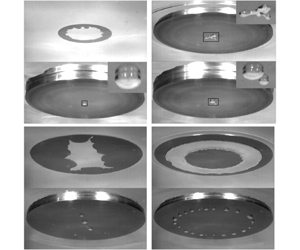Published online by Cambridge University Press: 03 July 2023

In this experimental work, a conus impacts a deep liquid pool at a speed varying from 1.3 to  $19.0\ {\rm cm}\ {\rm s}^{-1}$. Two liquids (2.5 % butanol–water solution or distilled water) and four coni made from duralumin with a diameter of 180 mm and different deadrise angles
$19.0\ {\rm cm}\ {\rm s}^{-1}$. Two liquids (2.5 % butanol–water solution or distilled water) and four coni made from duralumin with a diameter of 180 mm and different deadrise angles  $\beta$ (
$\beta$ ( $2^{\circ }$,
$2^{\circ }$,  $3^{\circ }$,
$3^{\circ }$,  $4^{\circ }$ and 5
$4^{\circ }$ and 5 $^{\circ }$) are tested. An air cushion is trapped between the conus solid surface and the liquid. Several types of bubble patterns after the collapse of the air cushion are observed: one or multiple bubbles near the conus centre (vertex), irregular trails of bubbles on the conus surface and a ring of bubbles in a ‘necklace’-shaped arrangement. With a total internal reflection set-up and appropriate image post-processing, the external and internal radii of the ring-shaped wetted area are estimated for each frame. The external (internal) radius increases (decreases) in time following a linear (exponential) law. The speed of the outer border of the wetted area is in agreement with the Wagner theory for a body impacting onto a liquid. The initial radius of the annular touchdown region is estimated as the intersection of the relevant fitting curves. In the studied range of parameters, the initial radius obeys a universal scaling law, which follows from the air–water lubrication–inertia balance.
$^{\circ }$) are tested. An air cushion is trapped between the conus solid surface and the liquid. Several types of bubble patterns after the collapse of the air cushion are observed: one or multiple bubbles near the conus centre (vertex), irregular trails of bubbles on the conus surface and a ring of bubbles in a ‘necklace’-shaped arrangement. With a total internal reflection set-up and appropriate image post-processing, the external and internal radii of the ring-shaped wetted area are estimated for each frame. The external (internal) radius increases (decreases) in time following a linear (exponential) law. The speed of the outer border of the wetted area is in agreement with the Wagner theory for a body impacting onto a liquid. The initial radius of the annular touchdown region is estimated as the intersection of the relevant fitting curves. In the studied range of parameters, the initial radius obeys a universal scaling law, which follows from the air–water lubrication–inertia balance.
Typical impact event. Experimental conditions : liquid BWS, V = 4.2 cm/s and β = 2°.
One bubble. Experimental conditions : liquid BWS, V = 7.7 cm/s and β = 2°.
Multiple bubbles. Experimental conditions : liquid BWS, V = 4.9 cm/s and β = 2°.
To send this article to your Kindle, first ensure no-reply@cambridge.org is added to your Approved Personal Document E-mail List under your Personal Document Settings on the Manage Your Content and Devices page of your Amazon account. Then enter the ‘name’ part of your Kindle email address below. Find out more about sending to your Kindle. Find out more about saving to your Kindle.
Note you can select to save to either the @free.kindle.com or @kindle.com variations. ‘@free.kindle.com’ emails are free but can only be saved to your device when it is connected to wi-fi. ‘@kindle.com’ emails can be delivered even when you are not connected to wi-fi, but note that service fees apply.
Find out more about the Kindle Personal Document Service.
To save this article to your Dropbox account, please select one or more formats and confirm that you agree to abide by our usage policies. If this is the first time you used this feature, you will be asked to authorise Cambridge Core to connect with your Dropbox account. Find out more about saving content to Dropbox.
To save this article to your Google Drive account, please select one or more formats and confirm that you agree to abide by our usage policies. If this is the first time you used this feature, you will be asked to authorise Cambridge Core to connect with your Google Drive account. Find out more about saving content to Google Drive.